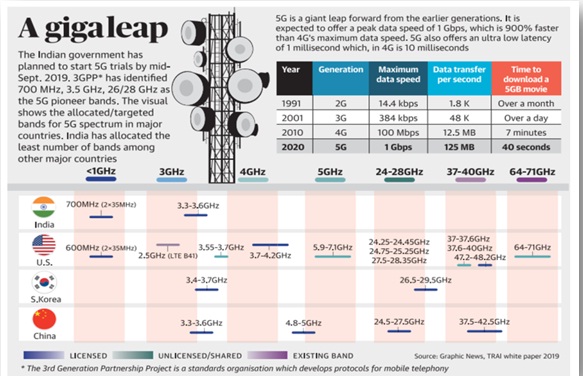|
Syllabus: Prelims GS Paper I : Current Events of National and International Importance; General Science
Mains GS Paper III : Science and Technology- Developments and their Applications and Effects in Everyday Life; Awareness in the fields of IT, Space, Computers, Robotics, Nano-technology, Bio-technology and issues relating to Intellectual Property Rights.
|
Context
Future Scope for 5G (Generation) with respect to the Indian Tele Communication Sector and Proposed Solution of Setting Up 5G.
Background
Recent announcement by the Center, that the Government will be holding auction for spectrum, which includes airwaves that will be used to offer 5G or fifth-generation services, in the current calendar year. While some countries such as South Korea and the U.S. have begun rolling out commercial 5G services, India is yet to begin trial for these even as the government is targeting 2020 as the launch year for 5G in the country.
What Is 5G?
5G is the next generation Internet technology, provides lightning fast speed and more reliable communication with ultra low latency.
Available data shows that the peak network speeds are expected to be in the range of 2-20 Gigabits per second (Gbps). This is in contrast to 4G link speeds in averaging 6-7 Megabit per second (Mbps) in India as compared to 25 Mbps in advanced countries.
Need and Viability of 5G
Worldwide, more than 40 telecom operators have already launched 5G. Technology is critical to India’s digital ambition. The constantly evolving need for higher speed, along with plans for smart cities, industrial automation, connected devices, etc, make 5G inevitable. So, it becomes critical for both operators and GoI to develop and adopt it in a speedy and efficient manner.
Essential Requirements for 5G Setup
Availability of Spectrum
Department of telecommunications (DoT) has earmarked 300 MHz in the mid-band spectrum of the 3.3-3.6 GHz range for 5G. This offers good coverage and speed, and has wide international consensus. Also, the sub-1GHz band, given its strength has good indoor coverage.
Technology
5G deployment will require overcoming several technological and operational challenges, the biggest one being extensive fiberisation. Most operators are at

about 20-25% fiberisation. However, a truly 5G experience will require upwards of 80% fiberisation.
Finances
Telecom operators are burdened with debt to the tune of Rs 4 lakh crore. They are still trying to fully monetize 4G services. 5G deployment will be a long-term, strategic decision for any operator, as it will involve a heavy upfront investment with a long payback period.
Policy
Government and operators should collaborate to create an ecosystem capable of leveraging 5G technology. A favorable policy will indirectly enable advances in areas including employment, technology and investment.
Benefits of 5G
India is focused on a digital agenda to transform the country, connecting its remotest corners so people can reap the benefits of digital inclusion. There is also a lot of emphasis on positioning the country as a global hub for the manufacturing, as part of the its Make in India campaign.
5G will bring socio-economic growth to nations in every corner of the nation. It will enable a connected, digital society and act as a core foundation for the Fourth Industrial Revolution, building on the scale of billions of connected devices.
As new 5G-enabled services and applications are realized, new jobs will be created and talent up-skilled and re-skilled. These developments will help in establishing and fostering a cleaner, safer and more sustainable society for current and future generations.
Technologies such as 5G and the Internet of Things can play a critical role in enhancing and enabling advances in this sector. They will provide much-needed gains in efficiency and profitability but, at the same time, will be the foundation to create new processes and innovations.
Major Issue
While finding the right spectrum is important, the main challenge will be pricing. The Telecom Regulatory Authority of India (TRAI) has suggested a base price at Rs 492 crore per MHz, an additional burden of about Rs 50,000 crore for 100 MHz. Its proposed reserve price is up to six times higher than that of similar spectrum sold recently in countries like South Korea, Spain, Britain and Italy. This makes additional financial challenge to Indian Telcos.
Conclusion
India to emerge as a manufacturing hub of global scale, a collaborative effort is required to build a secure and scalable national 5G infrastructure. India currently has a strong 4G footprint and it would be straightforward to build on this base and launch 5G, as other markets have. Active and continuous 5G trials and test-beds should be deployed to foster an environment of innovation and rapid adoption.
Connecting the Article
Question for Prelims
Which of the following are the advantages of 5G cellular technology?
1. It can help in space missions.
2. It can help in providing medical treatment facilities to the distant areas.
Select the correct answer using the code given below:
(a) 1 only
(b) 2 only
(c) Both 1 and 2
(d) Neither 1 nor 2
Question for Mains
What is 5G technology ? Examine its relevance for rural development in India. How it can help in decreasing Rural-Urban differences?

 Contact Us
Contact Us  New Batch : 9555124124/ 7428085757
New Batch : 9555124124/ 7428085757  Tech Support : 9555124124/ 7428085757
Tech Support : 9555124124/ 7428085757






